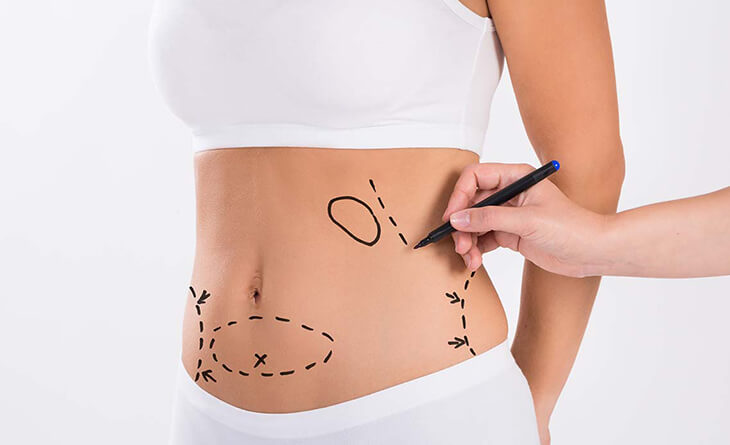What is Lipoabdominoplasty?
Lipoabdominoplasty is a surgical procedure done to rejuvenate the lower torso (the area from below the chest to the pubis). The procedure helps to achieve a flatter abdominal contour and restore the normal waistline definition and shape.

Am I a candidate for this procedure?
Adults of any age who are in good physical health, are moderately fit and have a near normal body mass index can be good candidates for this procedure.
You may want this procedure if
- Weight gain and /or Pregnancy has caused you to lose your abdominal shape and contour
- Waxing and waning of weight over time has caused excess fat accumulation and an overhanging lower abdomen
- You have undergone weight loss surgery and there is now excess loose overhanging skin on your abdomen.
About the Procedure
The surgery is performed under general anaesthesia or spinal/epidural anaesthesia. There are two parts to the surgery. The surgery begins with liposuction of the abdomen and waist areas to get rid of the excess fat under the skin in all areas of the abdomen and flanks. This helps to flatten the upper abdomen and also give the flanks / waist better definition and curves.
An incision similar to a Caesarean Section incision but extending from one hip bone to the other is made in the lowest part of the abdomen and the skin-fat apron is lifted up from the underlying muscle wall right upto the lower chest. The vertical muscles of the abdomen known as the rectus muscles may be repaired in the midline (if necessary) to close a gap / splaying part of the muscles that usually forms after weakening owing to the stretching force at pregnancy. This is done by placing strong internal stitches between the muscles along their whole length. This helps to reduce the upper abdominal bulge further.
Then the skin-fat envelope is pulled down like a shutter and all excess overhanging skin and fat in the lower abdomen is trimmed off. The edges of the incision are then brought together in multiple layers with strong stitches. Finally the belly button has to be re-fixed making its appearance more youthful.

What to expect after surgery and Do’s and Don’t’s
A Hospital stay of 24 to 48 hours after surgery is usually required for a lipoabdominoplasty. You will be mobilised out of bed on the next day itself and will encouraged to walk. After discharge, walking in the house for short periods is allowed. You may need help getting in and out of bed for the first few days and will feel tightness on the stitch line when you get up into a standing position. Bending slightly forward when in upright position, for a period of 8-10 days, helps to reduce the tightness and improves comfort.
Pain is well controlled with analgesics and moderate rest. The areas of liposuction (upper abdomen and flanks) are usually sore for 5-7 days whereas the abdominoplasty area (lower abdomen) is actually numb or has reduced sensations. A pressure garment or corset is mandatory to be worn 24/7 for a period of 6 weeks or more. A nutritious diet and adequate fluid intake definitely helps with good energy levels and comfort.
Dressings are necessary every 4th/5th day for approximately 2 weeks. Stitches are usually required to be removed from the belly button area on the 7th day whereas stitches over the main incision line are self-dissolving and do not need removal.
By the end of 5-7 days, your comfort and energy levels will be near normal and you may be permitted to resume work if your profession involves purely a desk job. Any strenuous physical activity is restricted for a period of 4-6 weeks. . All strenuous physical activities like running, jogging, going to the gym, swimming and any contact sports are to be restricted for a period of six weeks and should be resumed only after you have been given a green signal from your surgeon.
Even immediately after lipoabdominoplasty, the correction of the sagging, flabby lower abdomen to a much flatter outline is definitely noticeable. The result may be still masked by the swelling due to surgery which will gradually reduce over a period of 4-6 weeks. Approximately by the end of 2-3 months when the healing is complete and the swelling has completely disappeared, you will see gratifying final results – a flatter, firmer abdomen with a waistline definition which is suitable to your overall body structure.
What can go wrong with your procedure?
Seroma formation (Fluid accumulation beneath the skin envelope) – Sometimes there may be some fluid accumulation beneath your skin after the surgery. This is usually prevented by intra-operative placement of drainage tubes if your surgeon finds it necessary to do so at the end of your procedure. Rarely there is fluid accumulation in spite of the drainage tubes or after their removal. Usually, the condition is self-limiting and will settle on its own. In case of a large amount of persistent fluid collection, your surgeon may need to drain out the fluid by aspiration using a needle and syringe either once or several times.
Wound healing issues – Sometimes there may be wound breakdown of the main incision line. This is more common in cases where the closure is done under tension or the patient has restarted activities too early or in obese patients with thick fat layers. In such cases, the wound breakdown can often be dealt with by dressings alone till healing occurs. Rarely, the wound may need a minor re-suturing procedure to accelerate the healing process.
Scars- Abominoplasty suture-lines are long from one hip bone to the other. The position of the scar is usually well hidden beneath a normal undergarment. Depending on the extent of the surgery necessary to remove excess loose skin, the length of the scar varies from person to person. The healing and quality of the scar is also patient-related. A qualified Aesthetic surgeon will always discuss scar management protocols with you in order to achieve the least visible scar for you.
Changes in skin sensation- The operated area is likely to be numb for several months. Return of normal sensation is gradual over 3-6 months and takes place from the top to the bottom.
In general, it is a very gratifying surgery.
